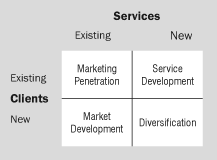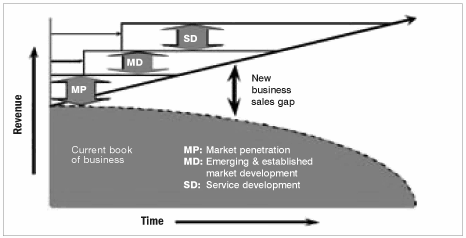Following a number of years in which revenue growth has been achievable without too much effort, there will be many management teams with the misplaced belief that they have a strong business model. In truth, during the bull years, the volumes of work available means that all can feast. A period of recession will provide evidence of those businesses with underlying strengths, as opposed to those that were simply in the right place at the right time.
Indeed, in the past recession has been as effective as a bush fire at clearing the ground of overgrowth and wasteful practices ? allowing strong firms to flourish and new energetic ventures to emerge. This is because one measure of a robust business model is a firm’s ability to sustain growth through a period of reduced market activity.
Operational effectiveness – do the simple things well
We start with a highly tactical plea to all firms. Ensure you secure the revenue already within your grasp by employing rigour in the management of projects, and diligence in doing the imple things well. It is true of many firms that partners point a finger at the management team; placing responsibility for the growth and health of the business firmly at their door, through mechanisms of grand planning and mould-breaking moves. In reality, achieving enhanced revenues is a multifaceted, incremental process, and each partner bears a personal responsibility for contributing a sliver of growth. Some of the ways in which this can be achieved include:
• Negotiate sensibly – no needless giveaways or unnecessary discounting;
• Having arrived at a commercial agreement with a client, work to the letter. Ensure that ecovery is maximised;
• Manage teams well, and put in place a project-management philosophy to ensure resources deployed are appropriate to the task and fees;
• Record all time employed on a project ? the practices of deliberate under-recording, making value judgments during the progress of a project about what will (or will not) ultimately be billable, and ‘managing’ the time recorded to the fee, should all be persona non grata in the firm. As well as making it impossible to bill appropriately, under-recording also creates difficulties in subsequently using management information to budget for similar work accurately;
• Manage invoicing – agree billing dates and cycles to make it easy for the accounts department of the client;
• Put in place robust credit-management policies;
• Ensure effective implementation of any price rises.
Ansoff matrix and sales gap analysis
The Ansoff matrix is one of the simplest and most effective models used in marketing and business development.

|
Figure 1. The Ansoff matrix. |
Proposed by Igor Ansoff in Corporate Strategy (1987), it suggests that any business has four fundamental marketing strategies to pursue. These are illustrated by a simple 2x2 matrix (Figure 1). They can be summarised as:
• Market penetration. Sell more existing services to existing clients;
• Market development. Sell existing services to new clients;
• Service development. Sell new services to existing clients;
• Diversification. Sell new services to new clients.
This sequence also represents the approach that should be adopted to give the greatest likelihood of success. Assuming there is good satisfaction with existing services among existing clients, it is far easier to expand sales here than to try and break new ground elsewhere. Interestingly, the Ansoff model also predicts it will be easier to sell existing services (for which one has reputation, track-record and market position) to non-clients than to sell new services to existing ones.
The psychological power of reputation and track record is a huge purchasing influence in all sectors; within professional services it is pre-eminent. Research consistently demonstrates that the lowering of perceived risk (as evidenced by reputation and track record) and the building of trust are the two most important determinants of success in selling professional services.
The challenge of selling a new service to a new client (ie. diversification) in sufficiently significant volumes to make a difference to the top line in any substantive way is recognised as being a slow-burn strategy. Within marketing planning, which typically has a 12-month horizon, such diversification activities are not even considered – they are on the longer-term business-planning agenda.

|
Figure 2. Marketing strategy over time. |
Figure 2 sets the classic strategic approach against a time line. The important constructs of the diagram are the revenue target and the rate of decline of the current book of business. The difference between the two at any point is the ‘new business sales gap’, the size of which is determined by the degree of stretch in the growth target, and the rate at which current business erodes over time.
For firms that are deal-driven and highly transactional in nature, the current book of business will erode quickly. Those with more annuity business will be able to predict cash flow into the future with more certainty. Firms with a project or major ‘disputes’ focus have a different challenge – cash flow will be predictable, but project pipeline management techniques will be needed to ensure that resources are well utilised, and that the ‘cliff face’ effect of one significant matter ending is compensated for by another ramping up.
However, across all firms and all markets, classical strategy theory is unequivocal in its recommendations – initially ‘max-out’ through market penetration; then move on to market development; and finally consider service development in order to maximise short-term revenue growth opportunities.
It is also fair to say that a focus on growing existing clients was, until relatively recently, considered the least glamorous of the available options in the testosteronerich, but common-sense poor, world inhabited by many professionals. Awards, accolades, reputations and rewards could ONLY be achieved by ‘knocking down the doors’ and adding new names to the client roster. Whether the new-found clients developed into longer-term sustainable sources of revenue was rarely measured.
Now, a much more balanced approach is, quite rightly, prevalent across professional-service firms, with client development recognised as key to enduring success. However, the ‘ownership’ of relationships is still an issue, with the stranglehold exerted by some partners being an effective choke on revenue development.
Cross-selling
A question often asked is ‘where does cross-selling sit’?
In truth, cross-selling in the professional-services context occupies a hybrid position. Selling a new service to an existing client, where the firm has an established service reputation elsewhere, should be sensibly positioned as more challenging than selling existing services to the same client, but easier than creating a new client relationship.
In many firms the challenges associated with the cross-selling of services emanate, not from the client’s propensity to purchase, but from the politics, attitudes and motivations prevalent within the firm. A structured approach to client management is the way to shine a light on these destructive behaviours and use the twin levers of transparency and peer pressure to bring about change.
Competitive analysis and the fiveforces model
The competitive context is also an important factor in deciding which growth strategies to pursue. A helpful framework to use in thinking through the various aspects of competitive activity is the ‘Five Forces’ model, first suggested by Michael Porter in his seminal work Competitive Advantage (1996).

|
Figure 3. Porter's 'five forces' model. |
Porter suggests five dimensions (Figure 3) that impact on competitive performance.
The threat from existing competitors is an area that necessarily receives attention, although the level of competitor knowledge in most firms leaves significant room for improvement. Issues such as pricing strategies, share of wallet with common clients, analysis of relationship strength and business-development initiatives, are examples of the range and quality of competitive knowledge that firms should seek in order to evaluate the likely success of their own growth strategies. Clearly, it is easier to strike where the competitor is weak, and the client has a requirement, than in a shrinking market that is also the focus for other firms.
The other dimensions of the fiveforces model should also be considered in the context of planning for growth. Taking, for example, the threat of new entrants ? growth will generally be more challenging in any market if the number of firms vying for the business increases without a
commensurate increase in fee volumes. If new entrants bring fresh skills, enhanced services or compelling propositions, an incumbent’s strategy may well shift from one of growth to one of preservation. In preparing for growth, the sensitivity of the markets (and clients) within which the firm operates to new entrants should be evaluated. Threats from new entrants can range from different geographies to those entering due to structural changes – the Legal Services Act, for example. It is also important to factor in the most fundamental resource used by firms – talent. Good people are in short supply and can command a premium. Indeed, one of the key constraints on successful strategic development for many firms is not a lack of ideas, opportunities or money, but a lack of available human resources, coupled with the timescale and cost of recruitment.
It does not require one to darken the portals of Harvard Business School to appreciate that the markets in which clients can apply pressure to pricing and service levels will be more challenging to grow in than those that do not have these characteristics. Often, the growth option will require remodelling of business processes and a new offer to create a value proposition (normally meaning more service for less money) that differentiates the firm.
In some segments of the professionalservices world, substitute products are a real and increasing threat. For example, the days when the domestic-conveyancing practice was the cash cow of the highstreet law firm are over – replaced by a low-cost base process mode.
As much of what professionals of every flavour do is ‘process rich’ (albeit, in some cases, very complex), it should be anticipated that substitute products will emerge. Initially affecting the ‘simple process’ end of the service mix, it is inevitable such models will climb the food chain, as IT and knowledge-management techniques improve. This is likely to lead to an increasingly large tranche of traditional services being delivered more cheaply and efficiently, but crucially, not being provided by professional-service firms as we currently conceive them. Increasing disaggregation of the value chain, and outsourcing of parts of the service process, are also likely to provide opportunities and threats for firms of all sizes. Strategies for growth in areas that are likely to be affected by substitute products need to be well thought through and tested.
Key client management
Successful firms now recognise the importance of the strategic management of client relationships generally, and the need for a focus on key clients particularly. This realisation has given rise to a new limb of business-development practices and internal organisation in order to deploy resources that ensure the achievement of three objectives. In order of priority for each key client, these are:
• Securing of current service lines and relationship together with their shielding from competitor activity;
• Evaluation of current opportunities, and where possible, the deepening of current service lines and relationships;
• Assessment of new opportunities and the broadening of the franchise into new service lines and new relationships.
Unsurprisingly this sequence of activity follows the business-development best practice illustrated by the Ansoff model.
The call to action
Defining what needs to be done requires analysis, insight, choice and planning. It is not always a straightforward exercise, but it is within the grasp of management teams, either with or without external assistance. Much more difficult is the implementation of the growth strategies and their adoption across the business.
We return here to the theme of simplicity and, furthermore, incrementalism. Growth will occasionally result from a market-changing innovation or the creation of a service offer that cannot be matched quickly by the competition. More often, however, it will flow from a multitude of things being done one per cent better. Within a growth culture, ambition and resilience are important bedfellows.
For many professionals this causes emotional tension. Without the quick return and instant plaudits of success, confidence can fade. The management team must not just define the strategy, stress-test it and prepare for implementation. They must also lead the charge and act as catalysts, removing the road blocks.
The businesses that are most successful are able to deliver the thinking, the attitudes and the actions that are prerequisites for sustainable growth.



